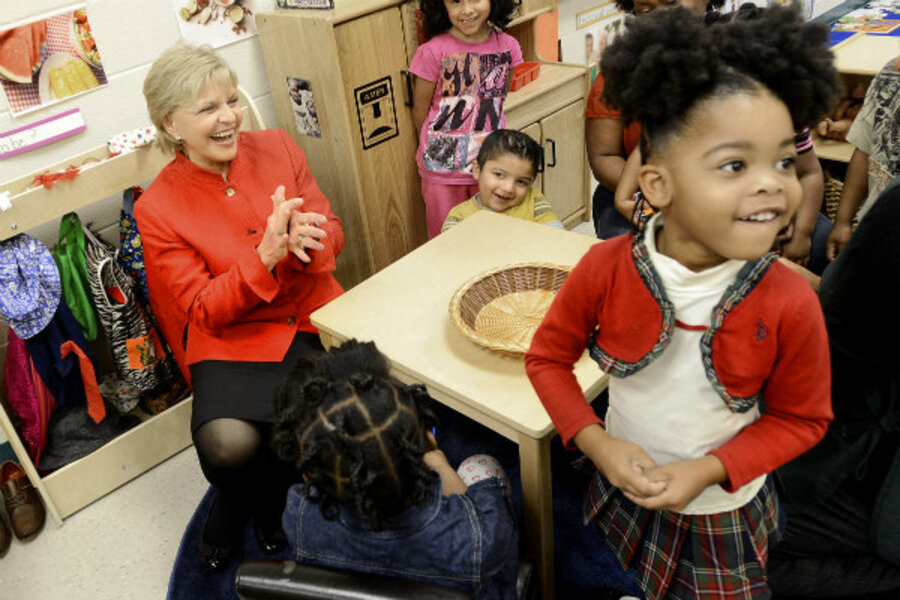Beyond the 'fiscal cliff,' America's kids need more – not less – government spending
Loading...
| Tucson, Ariz.
If President Obama, John Boehner, and House Republicans are unable to reach a deal to avoid the “fiscal cliff,” automatic spending cuts will cause states to lose an estimated $7.5 billion in federal funding for more than 100 grant programs, many of which are vital to low-income communities. Even if Washington averts the precipice, these programs face likely reductions in federal spending as part of an eventual budget deal. But lawmakers who want to preserve the “land of opportunity” by unsaddling future generations from debt should think twice about such cuts.
Once a world leader in equal opportunity, America now ranks behind many other affluent countries. Among adults aged 25 to 45 in 2000-2008, just 30 percent of those born into a family in the bottom fifth of incomes had reached the middle fifth of incomes or higher, whereas 80 percent of those born into the top fifth of earners had done so. That gap looks set to grow even larger, as differences in test scores and college graduation between children from low-income versus high-income homes have been rising since the 1970s.
We have, in short, a significant opportunity deficit for Americans who grow up in low-income families. And it's getting worse. Like it or not, a real solution will require more – not less – smart spending by government.
A host of social and economic shifts have contributed to the trend toward unequal opportunity. Children who grow up in a home with both of their biological parents are more likely to stay in school, avoid prison, and earn more in adulthood. The share of poorer children who grow up with both parents has fallen in the past several decades, while there has been far less change in family structure for those with higher incomes.
Parenting traits and behaviors have long differed according to parents' education and income, but this difference has increased with the advent of the modern intensive-parenting culture. Low-income parents aren't able to spend as much on goods and services aimed at enriching their children, such as music lessons, travel, and summer camp. Studies show they tend to read less to their children and provide less help with schoolwork. They are less likely to set and enforce clear rules and routines for their children. And they are less likely to encourage their children to aspire to high achievement in school and, later, at work.
Differences in out-of-home care also have widened. A generation ago, most preschool-aged kids stayed at home with their mothers. Now, many are in childcare of one sort or another. Children of affluent parents can attend education-oriented preschools, while kids of poorer parents are more likely to be left with a neighborhood babysitter who parks them in front of the television.
Children from poor backgrounds are less likely than others to enter and complete college, and in the past generation this difference has expanded, due in part to the rising cost of a college degree.
The job market has become more difficult, too. Technological advance, globalization, loss of manufacturing employment, union decline, and other developments have reduced the number of jobs that require limited skills but pay a solid wage – the kind that once moved poorer Americans into the middle class.
Family structure and behavior are key contributors to this opportunity deficit, but policymakers have limited means of influencing them. Nor can they magically create or revitalize community organizations to fill in where families falter. Yet when families, communities, and job markets fail low-income American children, government still can – and should – help.
The single most valuable step lawmakers could take would be to implement universal childcare and preschool. Think of it as extending public schooling down in the age range.
Here we can learn from the Scandinavian experience. Beginning in the 1960s, these countries introduced and steadily expanded publicly funded early education. Today, Danish and Swedish parents can take a paid year off from work following the birth of a child. After that, parents can put the child in a high-quality public or cooperative early education center. Parents pay a fee, but the cost is capped at around 10 percent of household income. The influence of parents' education, income, and parenting practices on their children's cognitive abilities, likelihood of completing high school and college, and labor market success tends to be weaker in these nations than in others.
But here in the US, if our existing public elementary and secondary schools fail to close the opportunity gap, why should we expect better results from a new early education system? Actually, our K-12 schools do help to offset the unequal effects of families and neighborhoods. In the absence of universal public schooling, the capabilities of American 18-year-olds would be even more unequal than they currently are.
Recent research by University of Chicago economist James Heckman and others finds that much of the gap between children from poor homes and those from affluent homes is already present by the time they enter kindergarten. Universal access to quality childcare and preschool wouldn't be a panacea, but it could help to make a big dent in this early opportunity deficit.
To close our yawning opportunity gap, all sides will need to bend somewhat. Conservatives and deficit hawks might recall that they have in the past been willing – wisely so – to allocate more money for opportunity-enhancing initiatives such as education funding and the Earned Income Tax Credit. Progressives might consider that getting the rich to carry a larger share of the tax burden will only reduce income inequality a little, and that universal early education and other opportunity-boosting measures would have more reach if funded by all of us.
Lane Kenworthy is a professor of sociology and political science at the University of Arizona. His essay “It’s Hard to Make It in America” is in the current issue of Foreign Affairs magazine.





